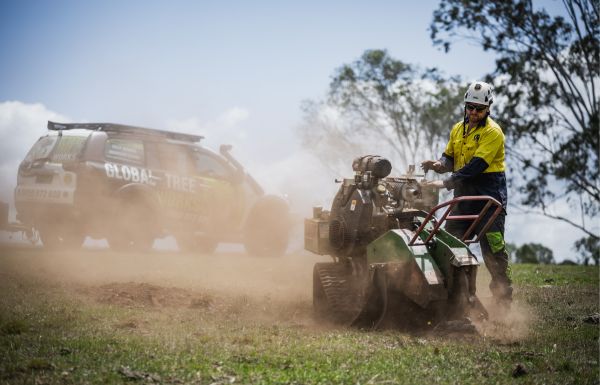
24 Apr To Grind or Not to Grind: Demystifying Stump Grinding for the Cautious Homeowner
For the seasoned gardener, the act of felling a tree for maintenance, aesthetics, or safety reasons isn’t just about the present but the future of their green haven. Yet, the decision to rid one’s premises of a tree goes beyond the act of cutting it down. One must consider what happens to the stump—immobile, unsightly, and possibly hazardous. This is where the technique of stump grinding comes into play, offering a solution that is both practical and beneficial.
Stump grinding is among the least understood processes in the domain of tree care. The concept of transforming a formidable stump into granule matter is both fascinating and vital for a multitude of reasons. In this guide, we break down the intricacies of stump grinding for the cautious homeowner, gardeners, and anyone vested in the preservation and curative maintenance of their outdoor spaces.
The What, Why, and How of Stump Grinding
Understanding Stump Grinding
Stump grinding is the mechanical process of shearing a tree stump down to ground level using a high-speed spinning blade. The resulting remnants are usually small wood chips or granules, effectively eliminating the above-ground aspect of the tree.
But why should this matter to you, the homeowner? The answer lies in the multifaceted benefits that stump grinding offers.
Reasons to Grind a Stump
The most apparent reason to grind a stump is the visual rejuvenation of the terrain. Stumps can be eyesores, serving as a constant reminder of the tree that once stood proudly. Yet, there is more at stake than aesthetics. Left unattended, stumps can pose hazards to both property and life, they can be havens for pests, and they can prevent further development of the area.
The Stump Grinding Process
Demystifying the stump grinding process can ease any reservations one might have. Typically conducted by professionals, a stump grinder is utilized to slowly convert the stubborn stump into manageable mulch, which can be distributed as per the homeowner’s preference.
The Case for Professional Stump Grinding Services
DIY Stump Grinding vs. Professional Expertise
There exists a segment of homeowners who, out of a sense of adventure or thrift, consider the DIY path. However, stump grinding is not a task that aligns with typical weekend warrior projects. It demands specialized equipment, the application of safety protocols, and a base of knowledge that only professional arborists possess.
Selecting the Right Stump Grinding Service
Recommending a professional stump grinding service involves evaluating the expertise, the methodology, and the collateral benefits offered. Homeowners must look for licensed and insured arborists who can provide a comprehensive service, including stump removal and post-grinding soil remediation.
The Cost of Stump Grinding
The financial investment in stump grinding is often questioned, as it is an extra step beyond tree removal. However, the costs associated with not grinding a stump, including potential damage to property or safety hazards, far outweigh the expense of professional services.
Post-Grinding Deliberations
Managing the Grind Debris
Once the stump is ground, homeowners are often left with an area filled with wood chips. These can be reimagined and repurposed for use as organic mulch, an eco-friendly solution that honors the tree posthumously.
Soil Health After Stump Grinding
Grinding a stump is not the end of the story; it’s the beginning of a new chapter for the soil. Post-grinding, the homeowner must consider soil amendments to promote healthy growth in the former tree’s space and prevent the proliferation of fungi and decay.
Future-Proofing Your Landscape
Grinding a stump is part of a continuum in landscape management. It can serve as a bridge to more proactive measures, such as selecting the right tree species for re-planting or reassessing the sun exposure and topography of the property for optimal landscape design.
The Environmental Angle
Stump Grinding and Sustainability
In a world increasingly aware of environmental impact, stump grinding stands out as a sustainable practice. By returning organic matter to the soil, it completes the life cycle of the tree in a manner that promotes ecological balance.
Frequently Asked Questions
Is Stump Grinding the Same as Stump Removal?
Stump grinding and stump removal are often used interchangeably, but they refer to different processes. Stump removal entails eradicating the entire stump, including roots, leaving a large hole that needs backfill. Stump grinding, on the other hand, involves removing the visible portion of the stump by grinding it to mulch, leaving the roots underground.
What Equipment is Used for Stump Grinding?
Stump grinding requires the use of a stump grinder, which is a heavy machinery equipped with a powerful rotating blade. Stump grinders can range in size and capabilities, but all are designed for the specific task of grinding stumps to mulch.
How Long Does Stump Grinding Take?
The duration of stump grinding depends on various factors, including the size of the stump, its age, wood hardness, and the grinder’s power. On average, grinding a medium-sized stump can take between 15 minutes to an hour. However, larger or harder stumps may take longer, and multiple stumps will add to the overall time.
In conclusion, the choice to grind a stump is a profound one that impacts the integrity, functionality, and beauty of your landscape. It is an investment in the future, an act of environmental stewardship, and a fundamental step in maintaining an outdoor space that reflects the pride and care you invest in it.
Approach stump grinding with the same diligence you would when choosing a tree—seek professional advice, understand the process, and appreciate its place in the broader canvas of your garden’s story. For when it comes to stumps, it is not just about where they’ve been, but where they leave you, and your garden, to grow.

